ECON 1246: Analyzing the Impact of US-China Trade War on Economies
VerifiedAdded on 2022/10/19
|9
|1559
|13
Report
AI Summary
This report analyzes the macroeconomic impacts of the US-China trade war, focusing on the effects on both countries and Australia. Part A provides background information, including trade statistics and the definition of a trade war. Part B examines the impact of tariffs, aggregate demand and supply shifts, and China's responses, including currency devaluation and restrictions on US companies, with a focus on real GDP and unemployment. Part C explores the specific effects on the Australian economy, including the decline in the Australian dollar, the impact on the ASX200, and the broader effects on bond markets and global growth. Part D concludes by highlighting the pressures on China to reach a trade deal due to its slowing economy and the shift of global firms away from China. The report uses various sources to support its arguments and provides a comprehensive overview of the complex economic issues involved.
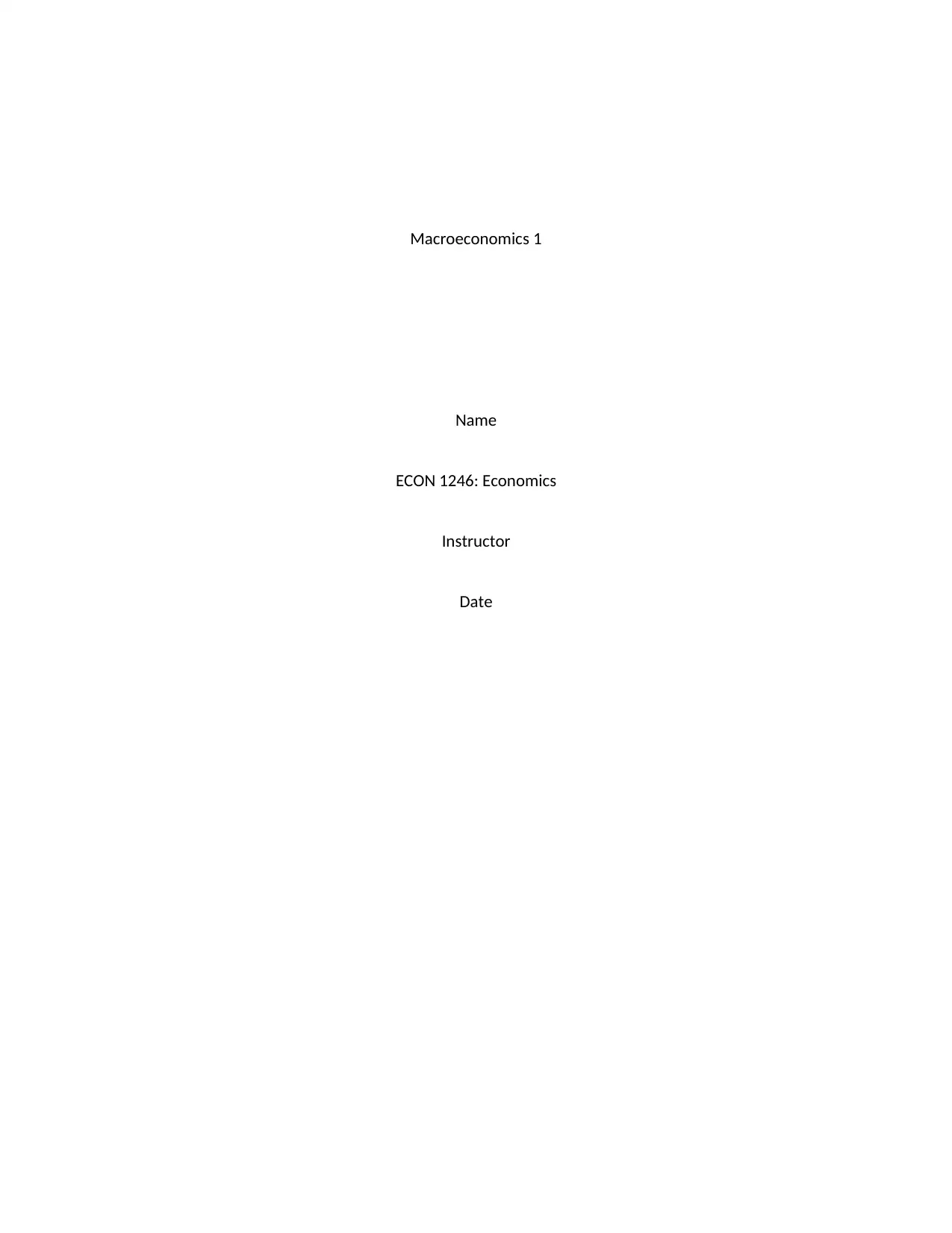
Macroeconomics 1
Name
ECON 1246: Economics
Instructor
Date
Name
ECON 1246: Economics
Instructor
Date
Paraphrase This Document
Need a fresh take? Get an instant paraphrase of this document with our AI Paraphraser
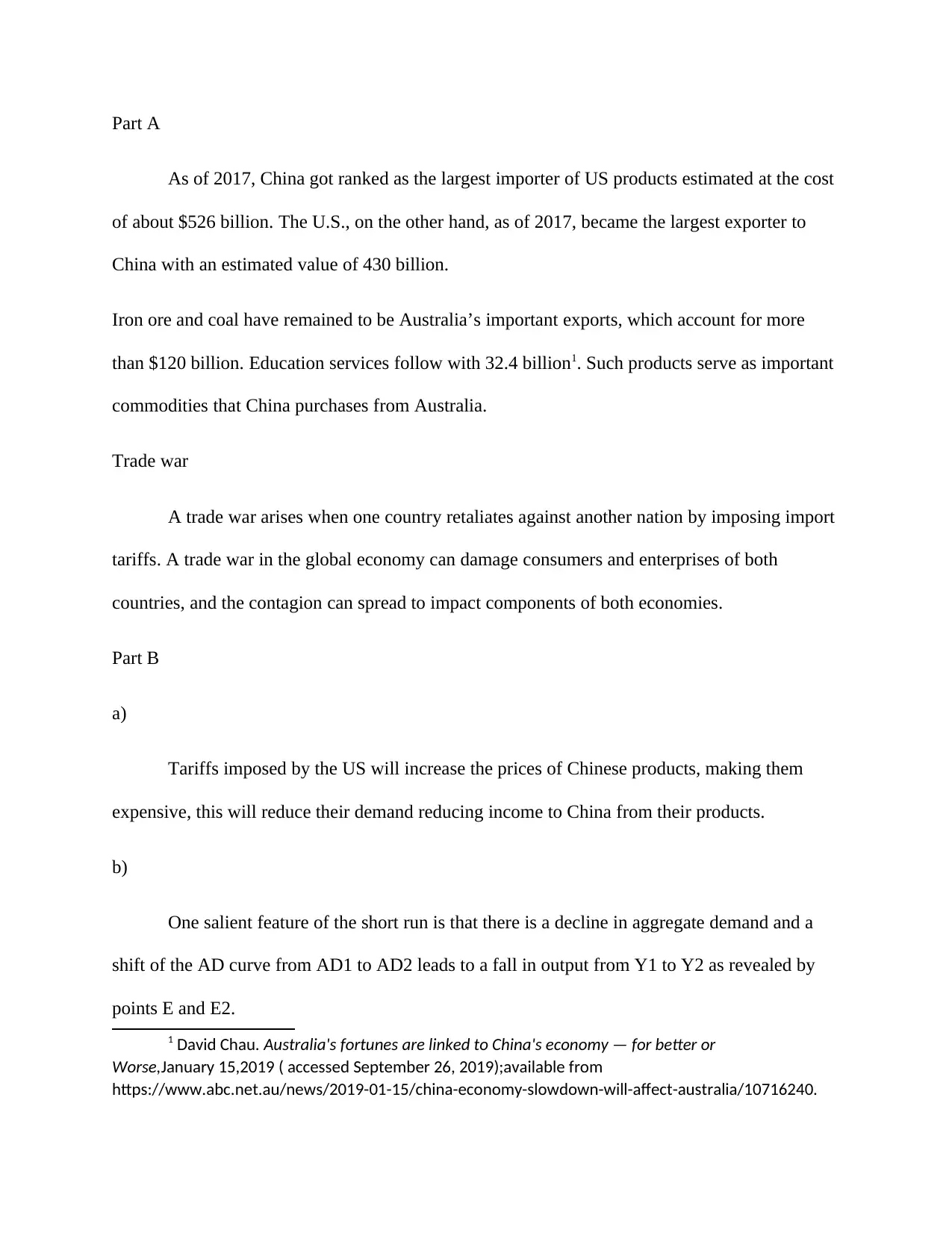
Part A
As of 2017, China got ranked as the largest importer of US products estimated at the cost
of about $526 billion. The U.S., on the other hand, as of 2017, became the largest exporter to
China with an estimated value of 430 billion.
Iron ore and coal have remained to be Australia’s important exports, which account for more
than $120 billion. Education services follow with 32.4 billion1. Such products serve as important
commodities that China purchases from Australia.
Trade war
A trade war arises when one country retaliates against another nation by imposing import
tariffs. A trade war in the global economy can damage consumers and enterprises of both
countries, and the contagion can spread to impact components of both economies.
Part B
a)
Tariffs imposed by the US will increase the prices of Chinese products, making them
expensive, this will reduce their demand reducing income to China from their products.
b)
One salient feature of the short run is that there is a decline in aggregate demand and a
shift of the AD curve from AD1 to AD2 leads to a fall in output from Y1 to Y2 as revealed by
points E and E2.
1 David Chau. Australia's fortunes are linked to China's economy — for better or
Worse,January 15,2019 ( accessed September 26, 2019);available from
https://www.abc.net.au/news/2019-01-15/china-economy-slowdown-will-affect-australia/10716240.
As of 2017, China got ranked as the largest importer of US products estimated at the cost
of about $526 billion. The U.S., on the other hand, as of 2017, became the largest exporter to
China with an estimated value of 430 billion.
Iron ore and coal have remained to be Australia’s important exports, which account for more
than $120 billion. Education services follow with 32.4 billion1. Such products serve as important
commodities that China purchases from Australia.
Trade war
A trade war arises when one country retaliates against another nation by imposing import
tariffs. A trade war in the global economy can damage consumers and enterprises of both
countries, and the contagion can spread to impact components of both economies.
Part B
a)
Tariffs imposed by the US will increase the prices of Chinese products, making them
expensive, this will reduce their demand reducing income to China from their products.
b)
One salient feature of the short run is that there is a decline in aggregate demand and a
shift of the AD curve from AD1 to AD2 leads to a fall in output from Y1 to Y2 as revealed by
points E and E2.
1 David Chau. Australia's fortunes are linked to China's economy — for better or
Worse,January 15,2019 ( accessed September 26, 2019);available from
https://www.abc.net.au/news/2019-01-15/china-economy-slowdown-will-affect-australia/10716240.
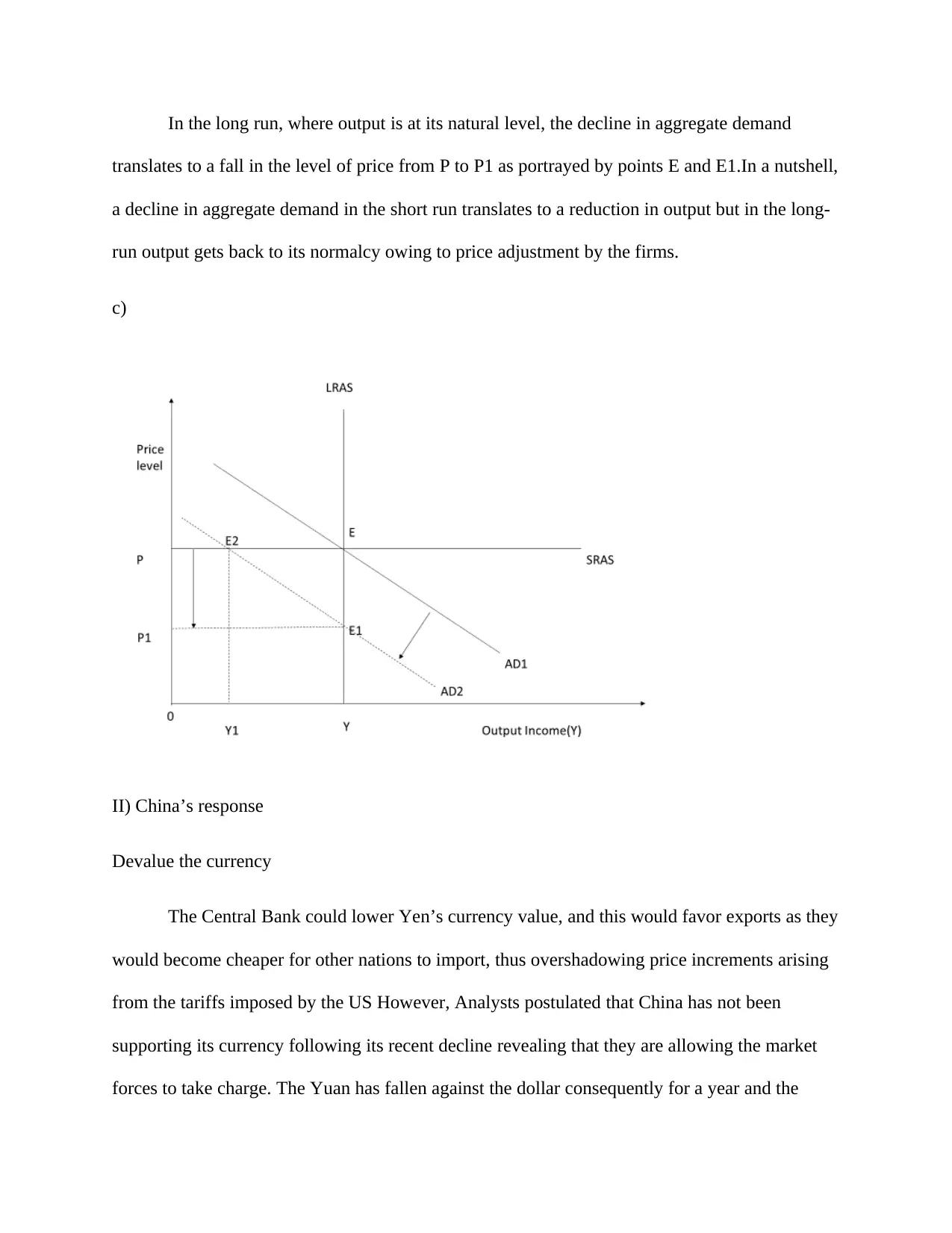
In the long run, where output is at its natural level, the decline in aggregate demand
translates to a fall in the level of price from P to P1 as portrayed by points E and E1.In a nutshell,
a decline in aggregate demand in the short run translates to a reduction in output but in the long-
run output gets back to its normalcy owing to price adjustment by the firms.
c)
II) China’s response
Devalue the currency
The Central Bank could lower Yen’s currency value, and this would favor exports as they
would become cheaper for other nations to import, thus overshadowing price increments arising
from the tariffs imposed by the US However, Analysts postulated that China has not been
supporting its currency following its recent decline revealing that they are allowing the market
forces to take charge. The Yuan has fallen against the dollar consequently for a year and the
translates to a fall in the level of price from P to P1 as portrayed by points E and E1.In a nutshell,
a decline in aggregate demand in the short run translates to a reduction in output but in the long-
run output gets back to its normalcy owing to price adjustment by the firms.
c)
II) China’s response
Devalue the currency
The Central Bank could lower Yen’s currency value, and this would favor exports as they
would become cheaper for other nations to import, thus overshadowing price increments arising
from the tariffs imposed by the US However, Analysts postulated that China has not been
supporting its currency following its recent decline revealing that they are allowing the market
forces to take charge. The Yuan has fallen against the dollar consequently for a year and the
⊘ This is a preview!⊘
Do you want full access?
Subscribe today to unlock all pages.

Trusted by 1+ million students worldwide
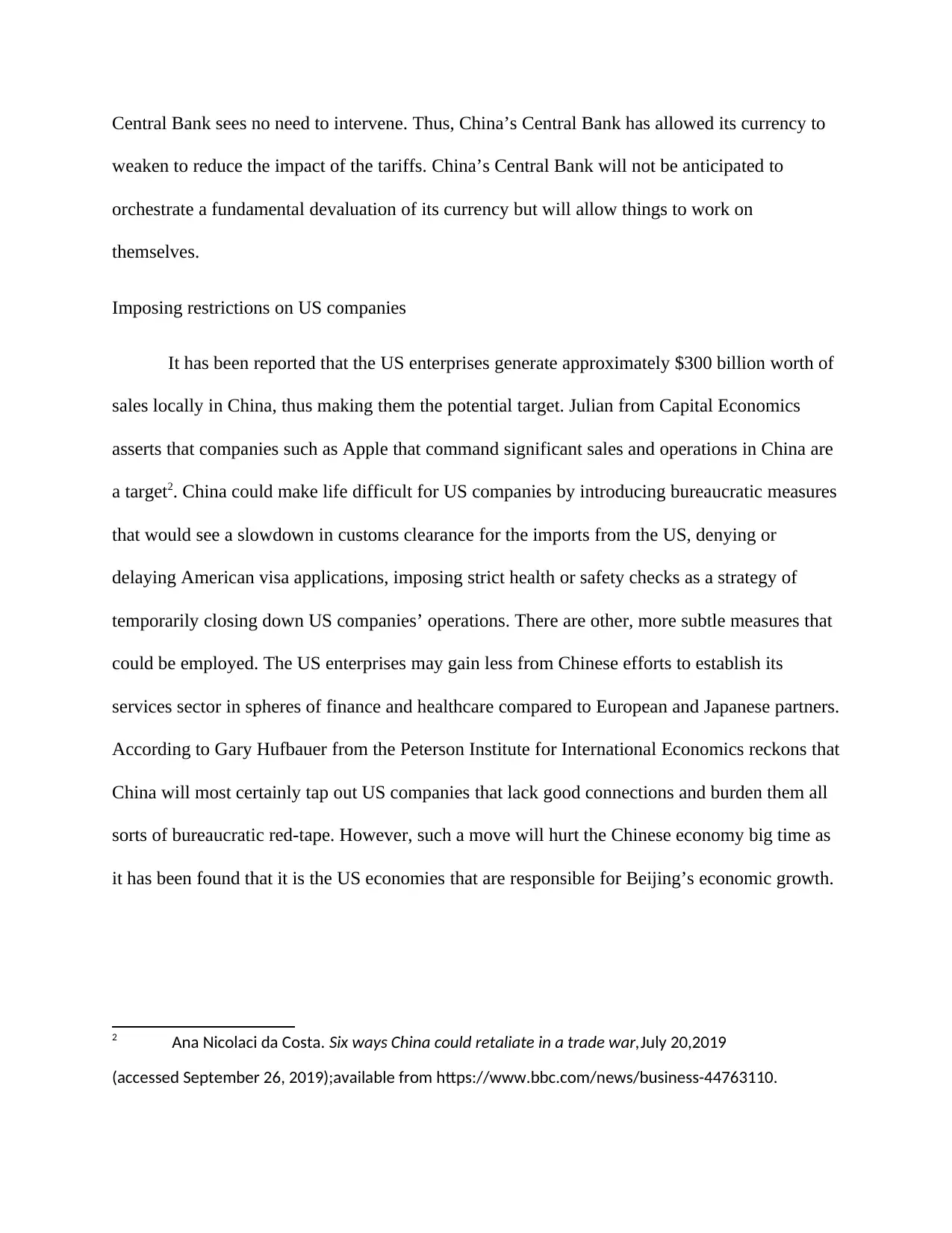
Central Bank sees no need to intervene. Thus, China’s Central Bank has allowed its currency to
weaken to reduce the impact of the tariffs. China’s Central Bank will not be anticipated to
orchestrate a fundamental devaluation of its currency but will allow things to work on
themselves.
Imposing restrictions on US companies
It has been reported that the US enterprises generate approximately $300 billion worth of
sales locally in China, thus making them the potential target. Julian from Capital Economics
asserts that companies such as Apple that command significant sales and operations in China are
a target2. China could make life difficult for US companies by introducing bureaucratic measures
that would see a slowdown in customs clearance for the imports from the US, denying or
delaying American visa applications, imposing strict health or safety checks as a strategy of
temporarily closing down US companies’ operations. There are other, more subtle measures that
could be employed. The US enterprises may gain less from Chinese efforts to establish its
services sector in spheres of finance and healthcare compared to European and Japanese partners.
According to Gary Hufbauer from the Peterson Institute for International Economics reckons that
China will most certainly tap out US companies that lack good connections and burden them all
sorts of bureaucratic red-tape. However, such a move will hurt the Chinese economy big time as
it has been found that it is the US economies that are responsible for Beijing’s economic growth.
2 Ana Nicolaci da Costa. Six ways China could retaliate in a trade war,July 20,2019
(accessed September 26, 2019);available from https://www.bbc.com/news/business-44763110.
weaken to reduce the impact of the tariffs. China’s Central Bank will not be anticipated to
orchestrate a fundamental devaluation of its currency but will allow things to work on
themselves.
Imposing restrictions on US companies
It has been reported that the US enterprises generate approximately $300 billion worth of
sales locally in China, thus making them the potential target. Julian from Capital Economics
asserts that companies such as Apple that command significant sales and operations in China are
a target2. China could make life difficult for US companies by introducing bureaucratic measures
that would see a slowdown in customs clearance for the imports from the US, denying or
delaying American visa applications, imposing strict health or safety checks as a strategy of
temporarily closing down US companies’ operations. There are other, more subtle measures that
could be employed. The US enterprises may gain less from Chinese efforts to establish its
services sector in spheres of finance and healthcare compared to European and Japanese partners.
According to Gary Hufbauer from the Peterson Institute for International Economics reckons that
China will most certainly tap out US companies that lack good connections and burden them all
sorts of bureaucratic red-tape. However, such a move will hurt the Chinese economy big time as
it has been found that it is the US economies that are responsible for Beijing’s economic growth.
2 Ana Nicolaci da Costa. Six ways China could retaliate in a trade war,July 20,2019
(accessed September 26, 2019);available from https://www.bbc.com/news/business-44763110.
Paraphrase This Document
Need a fresh take? Get an instant paraphrase of this document with our AI Paraphraser
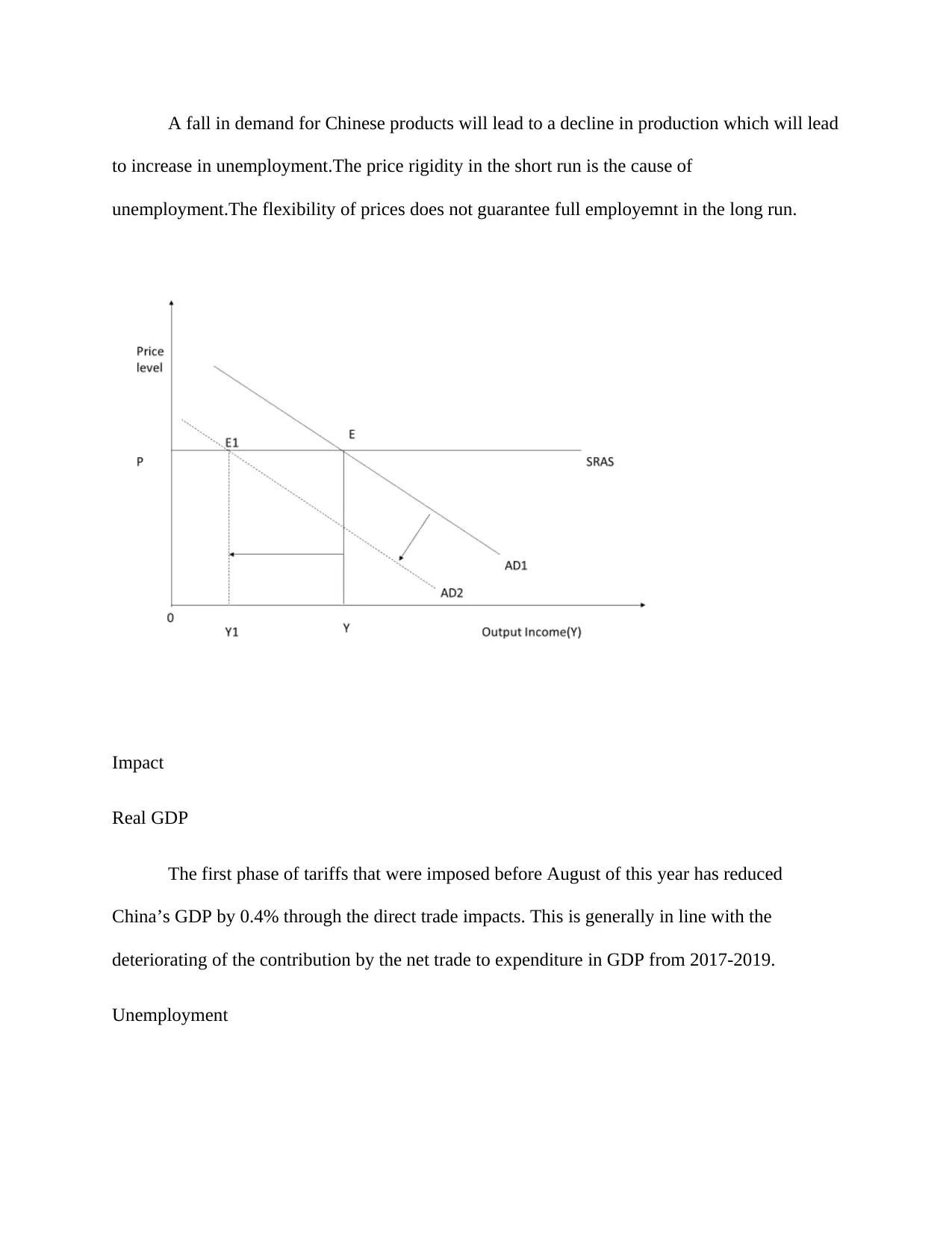
A fall in demand for Chinese products will lead to a decline in production which will lead
to increase in unemployment.The price rigidity in the short run is the cause of
unemployment.The flexibility of prices does not guarantee full employemnt in the long run.
Impact
Real GDP
The first phase of tariffs that were imposed before August of this year has reduced
China’s GDP by 0.4% through the direct trade impacts. This is generally in line with the
deteriorating of the contribution by the net trade to expenditure in GDP from 2017-2019.
Unemployment
to increase in unemployment.The price rigidity in the short run is the cause of
unemployment.The flexibility of prices does not guarantee full employemnt in the long run.
Impact
Real GDP
The first phase of tariffs that were imposed before August of this year has reduced
China’s GDP by 0.4% through the direct trade impacts. This is generally in line with the
deteriorating of the contribution by the net trade to expenditure in GDP from 2017-2019.
Unemployment
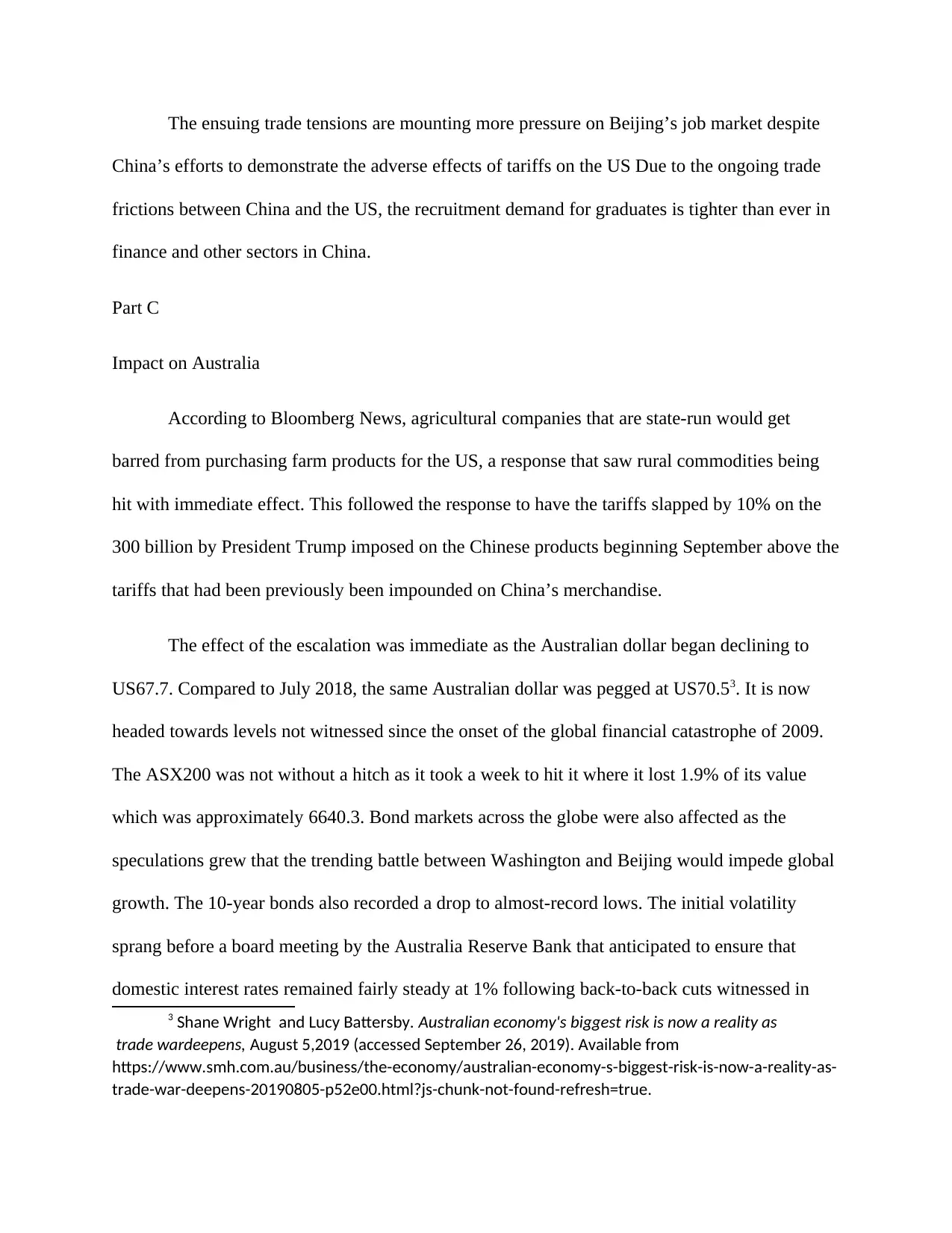
The ensuing trade tensions are mounting more pressure on Beijing’s job market despite
China’s efforts to demonstrate the adverse effects of tariffs on the US Due to the ongoing trade
frictions between China and the US, the recruitment demand for graduates is tighter than ever in
finance and other sectors in China.
Part C
Impact on Australia
According to Bloomberg News, agricultural companies that are state-run would get
barred from purchasing farm products for the US, a response that saw rural commodities being
hit with immediate effect. This followed the response to have the tariffs slapped by 10% on the
300 billion by President Trump imposed on the Chinese products beginning September above the
tariffs that had been previously been impounded on China’s merchandise.
The effect of the escalation was immediate as the Australian dollar began declining to
US67.7. Compared to July 2018, the same Australian dollar was pegged at US70.53. It is now
headed towards levels not witnessed since the onset of the global financial catastrophe of 2009.
The ASX200 was not without a hitch as it took a week to hit it where it lost 1.9% of its value
which was approximately 6640.3. Bond markets across the globe were also affected as the
speculations grew that the trending battle between Washington and Beijing would impede global
growth. The 10-year bonds also recorded a drop to almost-record lows. The initial volatility
sprang before a board meeting by the Australia Reserve Bank that anticipated to ensure that
domestic interest rates remained fairly steady at 1% following back-to-back cuts witnessed in
3 Shane Wright and Lucy Battersby. Australian economy's biggest risk is now a reality as
trade wardeepens, August 5,2019 (accessed September 26, 2019). Available from
https://www.smh.com.au/business/the-economy/australian-economy-s-biggest-risk-is-now-a-reality-as-
trade-war-deepens-20190805-p52e00.html?js-chunk-not-found-refresh=true.
China’s efforts to demonstrate the adverse effects of tariffs on the US Due to the ongoing trade
frictions between China and the US, the recruitment demand for graduates is tighter than ever in
finance and other sectors in China.
Part C
Impact on Australia
According to Bloomberg News, agricultural companies that are state-run would get
barred from purchasing farm products for the US, a response that saw rural commodities being
hit with immediate effect. This followed the response to have the tariffs slapped by 10% on the
300 billion by President Trump imposed on the Chinese products beginning September above the
tariffs that had been previously been impounded on China’s merchandise.
The effect of the escalation was immediate as the Australian dollar began declining to
US67.7. Compared to July 2018, the same Australian dollar was pegged at US70.53. It is now
headed towards levels not witnessed since the onset of the global financial catastrophe of 2009.
The ASX200 was not without a hitch as it took a week to hit it where it lost 1.9% of its value
which was approximately 6640.3. Bond markets across the globe were also affected as the
speculations grew that the trending battle between Washington and Beijing would impede global
growth. The 10-year bonds also recorded a drop to almost-record lows. The initial volatility
sprang before a board meeting by the Australia Reserve Bank that anticipated to ensure that
domestic interest rates remained fairly steady at 1% following back-to-back cuts witnessed in
3 Shane Wright and Lucy Battersby. Australian economy's biggest risk is now a reality as
trade wardeepens, August 5,2019 (accessed September 26, 2019). Available from
https://www.smh.com.au/business/the-economy/australian-economy-s-biggest-risk-is-now-a-reality-as-
trade-war-deepens-20190805-p52e00.html?js-chunk-not-found-refresh=true.
⊘ This is a preview!⊘
Do you want full access?
Subscribe today to unlock all pages.

Trusted by 1+ million students worldwide
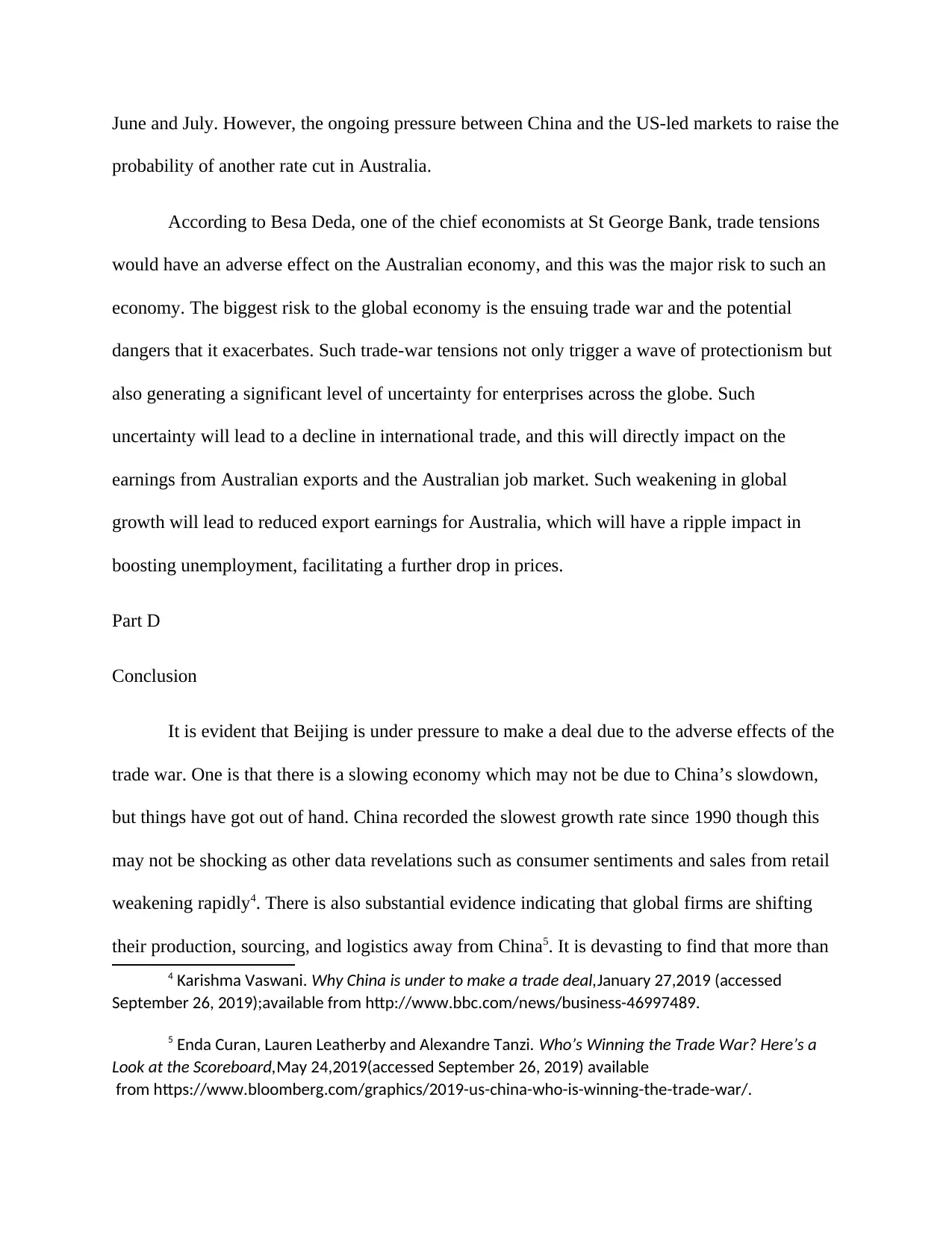
June and July. However, the ongoing pressure between China and the US-led markets to raise the
probability of another rate cut in Australia.
According to Besa Deda, one of the chief economists at St George Bank, trade tensions
would have an adverse effect on the Australian economy, and this was the major risk to such an
economy. The biggest risk to the global economy is the ensuing trade war and the potential
dangers that it exacerbates. Such trade-war tensions not only trigger a wave of protectionism but
also generating a significant level of uncertainty for enterprises across the globe. Such
uncertainty will lead to a decline in international trade, and this will directly impact on the
earnings from Australian exports and the Australian job market. Such weakening in global
growth will lead to reduced export earnings for Australia, which will have a ripple impact in
boosting unemployment, facilitating a further drop in prices.
Part D
Conclusion
It is evident that Beijing is under pressure to make a deal due to the adverse effects of the
trade war. One is that there is a slowing economy which may not be due to China’s slowdown,
but things have got out of hand. China recorded the slowest growth rate since 1990 though this
may not be shocking as other data revelations such as consumer sentiments and sales from retail
weakening rapidly4. There is also substantial evidence indicating that global firms are shifting
their production, sourcing, and logistics away from China5. It is devasting to find that more than
4 Karishma Vaswani. Why China is under to make a trade deal,January 27,2019 (accessed
September 26, 2019);available from http://www.bbc.com/news/business-46997489.
5 Enda Curan, Lauren Leatherby and Alexandre Tanzi. Who’s Winning the Trade War? Here’s a
Look at the Scoreboard,May 24,2019(accessed September 26, 2019) available
from https://www.bloomberg.com/graphics/2019-us-china-who-is-winning-the-trade-war/.
probability of another rate cut in Australia.
According to Besa Deda, one of the chief economists at St George Bank, trade tensions
would have an adverse effect on the Australian economy, and this was the major risk to such an
economy. The biggest risk to the global economy is the ensuing trade war and the potential
dangers that it exacerbates. Such trade-war tensions not only trigger a wave of protectionism but
also generating a significant level of uncertainty for enterprises across the globe. Such
uncertainty will lead to a decline in international trade, and this will directly impact on the
earnings from Australian exports and the Australian job market. Such weakening in global
growth will lead to reduced export earnings for Australia, which will have a ripple impact in
boosting unemployment, facilitating a further drop in prices.
Part D
Conclusion
It is evident that Beijing is under pressure to make a deal due to the adverse effects of the
trade war. One is that there is a slowing economy which may not be due to China’s slowdown,
but things have got out of hand. China recorded the slowest growth rate since 1990 though this
may not be shocking as other data revelations such as consumer sentiments and sales from retail
weakening rapidly4. There is also substantial evidence indicating that global firms are shifting
their production, sourcing, and logistics away from China5. It is devasting to find that more than
4 Karishma Vaswani. Why China is under to make a trade deal,January 27,2019 (accessed
September 26, 2019);available from http://www.bbc.com/news/business-46997489.
5 Enda Curan, Lauren Leatherby and Alexandre Tanzi. Who’s Winning the Trade War? Here’s a
Look at the Scoreboard,May 24,2019(accessed September 26, 2019) available
from https://www.bloomberg.com/graphics/2019-us-china-who-is-winning-the-trade-war/.
Paraphrase This Document
Need a fresh take? Get an instant paraphrase of this document with our AI Paraphraser
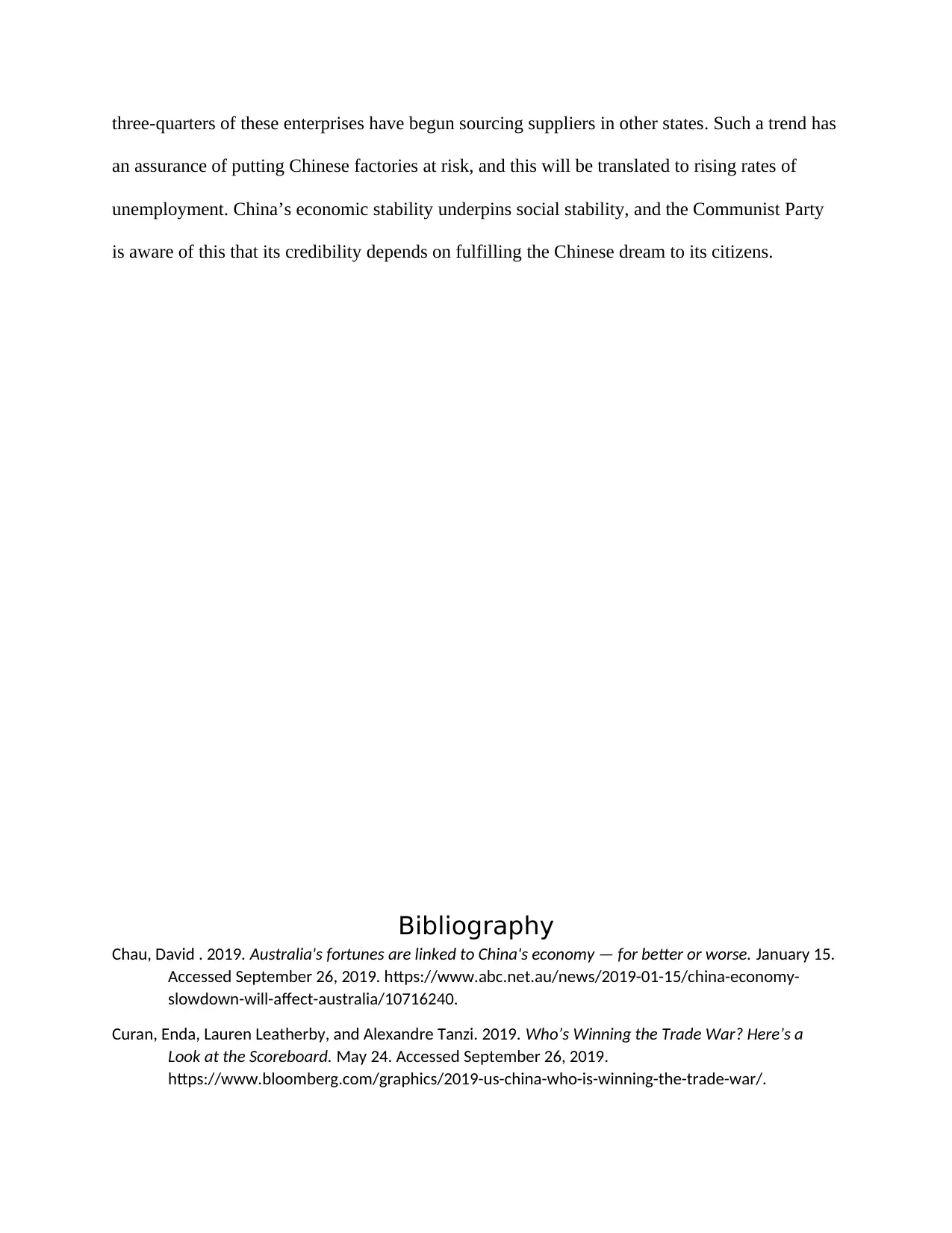
three-quarters of these enterprises have begun sourcing suppliers in other states. Such a trend has
an assurance of putting Chinese factories at risk, and this will be translated to rising rates of
unemployment. China’s economic stability underpins social stability, and the Communist Party
is aware of this that its credibility depends on fulfilling the Chinese dream to its citizens.
Bibliography
Chau, David . 2019. Australia's fortunes are linked to China's economy — for better or worse. January 15.
Accessed September 26, 2019. https://www.abc.net.au/news/2019-01-15/china-economy-
slowdown-will-affect-australia/10716240.
Curan, Enda, Lauren Leatherby, and Alexandre Tanzi. 2019. Who’s Winning the Trade War? Here’s a
Look at the Scoreboard. May 24. Accessed September 26, 2019.
https://www.bloomberg.com/graphics/2019-us-china-who-is-winning-the-trade-war/.
an assurance of putting Chinese factories at risk, and this will be translated to rising rates of
unemployment. China’s economic stability underpins social stability, and the Communist Party
is aware of this that its credibility depends on fulfilling the Chinese dream to its citizens.
Bibliography
Chau, David . 2019. Australia's fortunes are linked to China's economy — for better or worse. January 15.
Accessed September 26, 2019. https://www.abc.net.au/news/2019-01-15/china-economy-
slowdown-will-affect-australia/10716240.
Curan, Enda, Lauren Leatherby, and Alexandre Tanzi. 2019. Who’s Winning the Trade War? Here’s a
Look at the Scoreboard. May 24. Accessed September 26, 2019.
https://www.bloomberg.com/graphics/2019-us-china-who-is-winning-the-trade-war/.
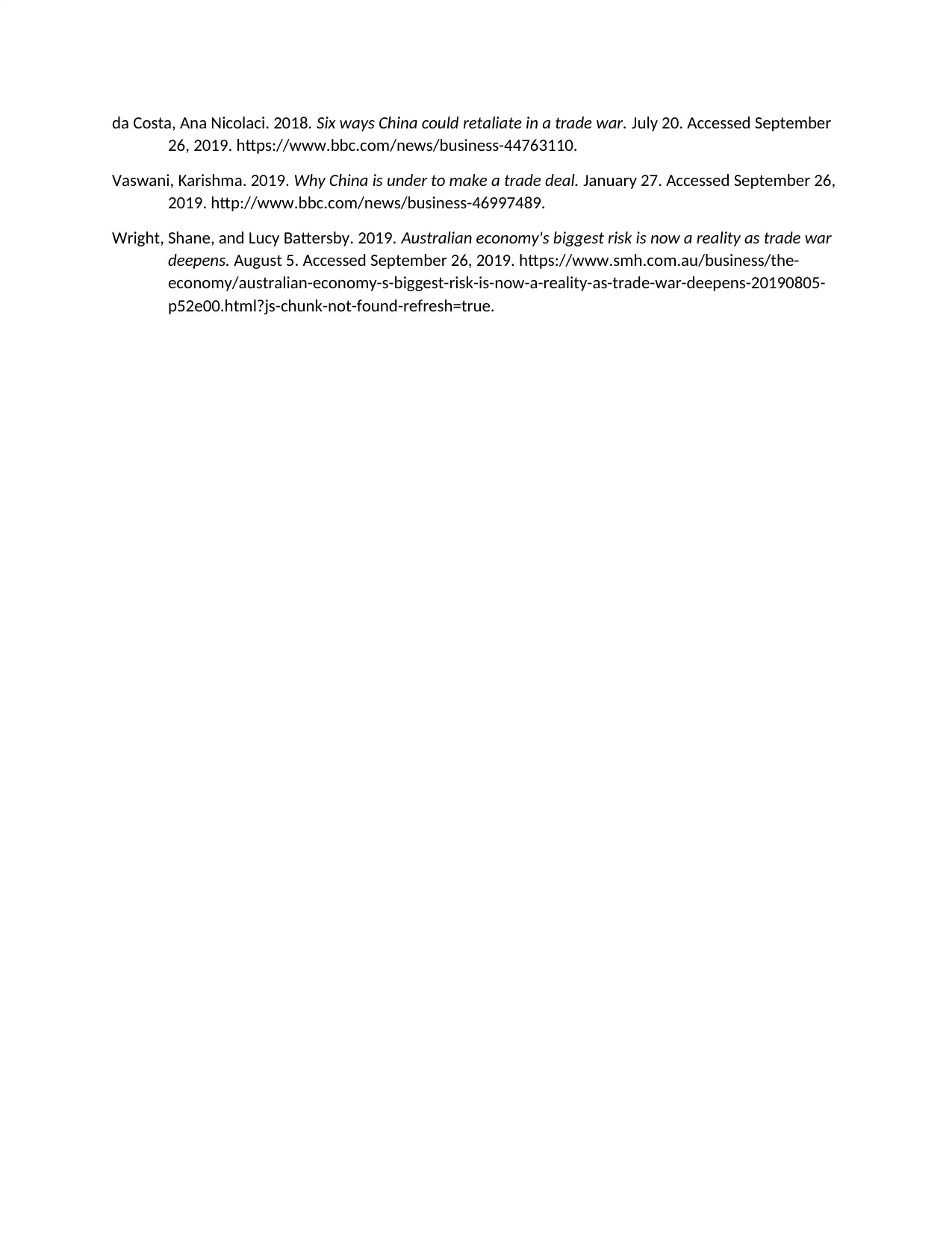
da Costa, Ana Nicolaci. 2018. Six ways China could retaliate in a trade war. July 20. Accessed September
26, 2019. https://www.bbc.com/news/business-44763110.
Vaswani, Karishma. 2019. Why China is under to make a trade deal. January 27. Accessed September 26,
2019. http://www.bbc.com/news/business-46997489.
Wright, Shane, and Lucy Battersby. 2019. Australian economy's biggest risk is now a reality as trade war
deepens. August 5. Accessed September 26, 2019. https://www.smh.com.au/business/the-
economy/australian-economy-s-biggest-risk-is-now-a-reality-as-trade-war-deepens-20190805-
p52e00.html?js-chunk-not-found-refresh=true.
26, 2019. https://www.bbc.com/news/business-44763110.
Vaswani, Karishma. 2019. Why China is under to make a trade deal. January 27. Accessed September 26,
2019. http://www.bbc.com/news/business-46997489.
Wright, Shane, and Lucy Battersby. 2019. Australian economy's biggest risk is now a reality as trade war
deepens. August 5. Accessed September 26, 2019. https://www.smh.com.au/business/the-
economy/australian-economy-s-biggest-risk-is-now-a-reality-as-trade-war-deepens-20190805-
p52e00.html?js-chunk-not-found-refresh=true.
⊘ This is a preview!⊘
Do you want full access?
Subscribe today to unlock all pages.

Trusted by 1+ million students worldwide
1 out of 9
Related Documents
Your All-in-One AI-Powered Toolkit for Academic Success.
+13062052269
info@desklib.com
Available 24*7 on WhatsApp / Email
![[object Object]](/_next/static/media/star-bottom.7253800d.svg)
Unlock your academic potential
Copyright © 2020–2025 A2Z Services. All Rights Reserved. Developed and managed by ZUCOL.





